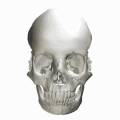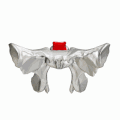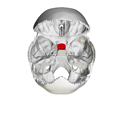土耳其鞍(Sella turcica)意即土耳其椅,又名蝶鞍,為蝶骨上一鞍型構造,存在於人、黑猩猩、猩猩及大猩猩等人科動物的顱骨上。為頭影測量的標誌位置。
| 蝶鞍 | |
|---|---|
 Human skull seen from side (parietal bones and temporal bones have been removed). Sella turcica shown in red. | |
 蝶鞍及腦下垂體 | |
| 标识字符 | |
| 拉丁文 | Sella turcica |
| MeSH | D012658 |
| TA98 | A02.1.05.006 |
| TA2 | 589 |
| FMA | FMA:54709 |
| 格雷氏 | p.147 |
| 《骨骼解剖学术语》 [在维基数据上编辑] | |
土耳其鞍位于颅中窝正中部、蝶骨体上部;形似马鞍状;包括垂体窝、鞍结节、中床突、交叉前沟、视神经管、前床突、鞍背和后床突等结构。
土耳其鞍是颅内骨结构的解剖学名称,指的是蝶骨在颅中窝中间部分高起,形如马鞍的骨结构。蝶鞍中央凹陷叫垂体窝,容纳脑垂体。正常情况下,蝶鞍与脑垂体之间紧密相贴,几乎没有空隙。当各种病理因素导致蝶鞍变形(鞍隔缺损)、扩大或脑垂体萎缩变小,使蝶鞍中央凹陷与脑垂体之间的间隙扩大,形成“空泡”样改变,在颅骨X片、脑室造影、CT或脑部核磁共振检查时可发现明显的密度降低形如“空泡”的影像,称为蝶鞍空泡(empty sella)。
構造
土耳其鞍的位置位於腦垂腺窩中。腦垂腺窩是固定腦垂腺的位置,位於蝶骨的凹坑中。而位於腦垂體窩前的則是鞍結
功能
蝶鞍構成固定腦下垂體的空間。
辭源
土耳其鞍的原文「Sella turcica」是拉丁文、「sella」是「座椅」的意思,而「turcica」則是土耳其的的意思。
參見
本條目使用了部分解剖術語。
- Sphenoidal sinuses
- Empty sella syndrome
附加圖像
-
人類顱骨顳面照(顳骨已移除),紅色部分為土耳其鞍。
-
蝶骨俯視照,紅色部分為土耳其鞍。
-
Human skull seen from top (parietal bones have been removed). Sella turcica shown in red.
-
Sphenoid bone. Upper surface. (There is no label for "Sella turcica", but "Tuberculum sellae" and "Fossa hypophyseos" are visible near center.)
-
Medial wall of left orbit. (Sella turcica labeled in upper right.)
-
Lateral wall of nasal cavity, showing ethmoid bone in position.
-
Base of skull - sella turcica
-
Base of skull - dorsum sellae
-
Base of skull - tuberculum sellae and hypophyseal fossa
參考文獻
- Marieb, Elaine Nicpon. Human Anatomy & Physiology 6th. Pearson Education. 2004: 209. ISBN 0-8053-5462-X.
外部連結
- Image at Indiana.edu (页面存档备份,存于互联网档案馆)
- eMedicine Dictionary上的Sella+turcica
Wikiwand in your browser!
Seamless Wikipedia browsing. On steroids.
Every time you click a link to Wikipedia, Wiktionary or Wikiquote in your browser's search results, it will show the modern Wikiwand interface.
Wikiwand extension is a five stars, simple, with minimum permission required to keep your browsing private, safe and transparent.










